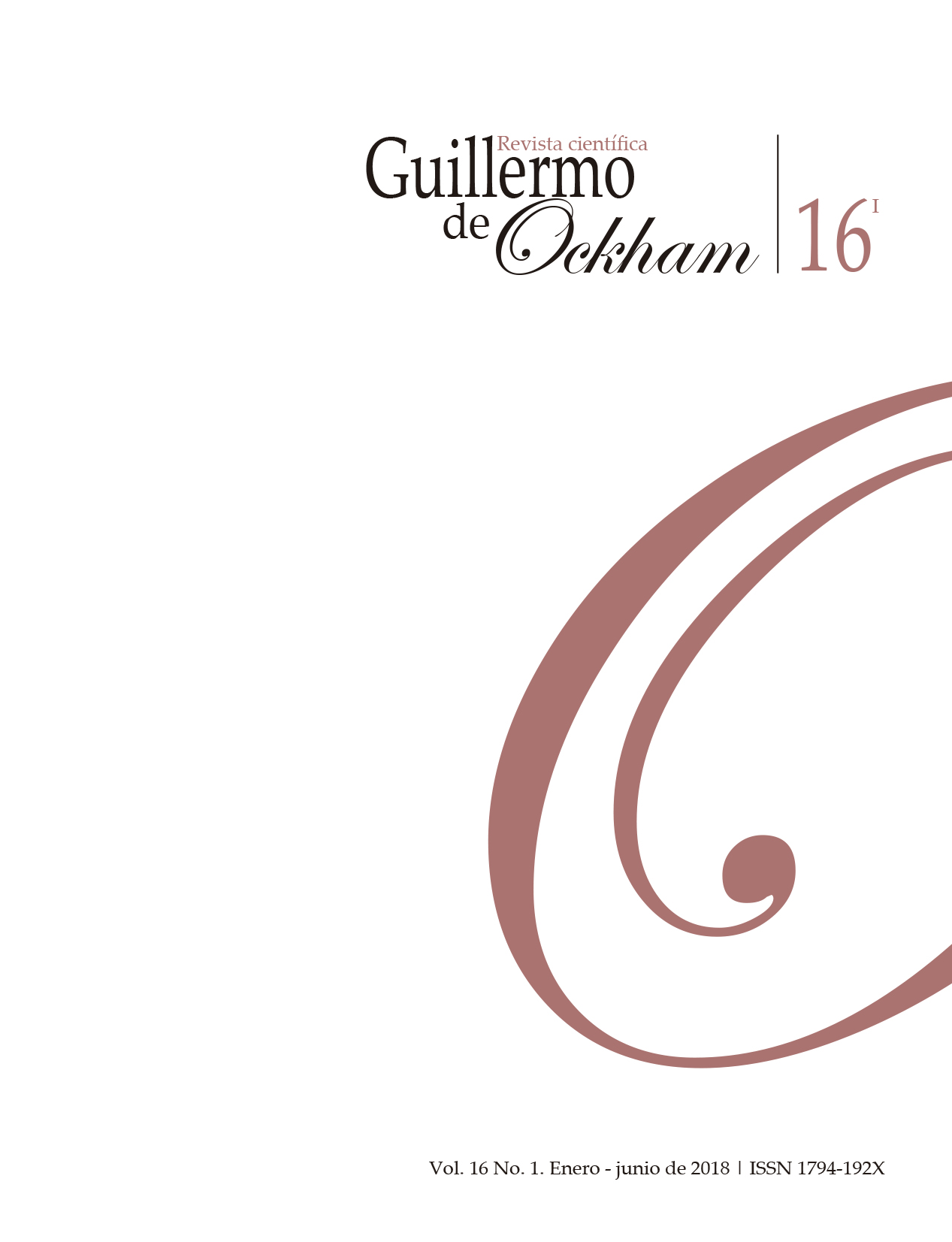The Revista Guillermo de Ockham provides an immediate and open access to its content, based on the principle of offering the public a free access to investigations to provide a global interchange of knowledge.
Unless otherwise established, the contents of this journal has a license with Creative Commons Attribution-NonCommercial-NoDerivatives 4.0 International (CC BY-NC-ND 4.0) http://creativecommons.org/licenses/by-nc-nd/4.0/
- Attribution: You must give appropriate credit, provide a link to the license, and indicate if changes were made. You may do so in any reasonable manner, but not in any way that suggests the licensor endorses you or your use.
- NonCommercial: You may not use the material for commercial purposes.
- NoDerivatives: If you remix, transform, or build upon the material, you may not distribute the modified material.
- No additional restrictions: You may not apply legal terms or technological measures that legally restrict others from doing anything the license permits.
Abstract
La relación entre determinados factores psicológicos y la vulnerabilidad que presenta un deportista para sufrir una lesión ha sido estudiada en los últimos años. Uno de los aspectos a considerar es la influencia de las conductas de riesgo del deportista en la probabilidad de sufrir una lesión. El presente estudio pretende estudiar si la tendencia al riesgo es un factor que está relacionado con la lesión deportiva. Por tanto, el objetivo es determinar si existen diferencias en los niveles de tendencia al riesgo entre jugadoras de fútbol y fútbol sala lesionadas y no lesionadas. Para ello, un total de 102 jugadoras de fútbol y fútbol sala femenino, de edades comprendidas entre los 12 y los 37 años y pertenecientes a clubes federados de la Región de Murcia participaron en esta investigación. Para la obtención de los datos, se empleó la versión española del cuestionario DOSPERT (Domain Specific Risk Taking) para adultos (Blais & Weber, 2006). Los resultados obtenidos en este estudio no muestran diferencias estadísticamente significativas entre los dos grupos analizados (lesionadas y no lesionadas), aunque parece existir una tendencia a presentar puntuaciones superiores en la variable tendencia al riesgo entre las jugadoras pertenecientes al grupo lesionado.
References
Bahr, R., & Krosshaug, T. (2005). Understanding injury mechanisms: a key component of preventing injuries in sport. British Journal of Sports Medicine, 39, 324-329.
Bianco, T., & Eklund, R. C. (2001). Conceptual considerations for social support research in sport and exercise settings: The case of sport injury. Journal of Sport and Exercise Psychology, 23(2), 85-107.
Blais, A., & Weber, E. (2006). A Domain-specific Risk-taking (DOSPERT) scale for adult populations. Judgement and Decision Making, 1(1), 33-47.
Brewer, B. W., & Redmond, C. (2016). Psychology of Sport Injury. Champaign, IL: Human Kinetics.
Bromley, P., & Curley, S. P. (1992). Individual differences in risk taking. In J. F. Yates (Ed.), Risk-taking behavior, pp. 87-132. New York: Wiley.
Burn, D., Morris, T. M., & Andersen, M. B. (1996). Stress, life stress, and visual attention. In Proceedings of an International Congress on Stress and Health. Edited by: Kenny, D. Sydney: The University of Sydney.
Cook, S., Peterson, L., & DiLillo, D. (1999). Fear and exhilaration in response to risk: An extension of a model of injury risk in a real-world context. Behavior Therapy, 30(1), 5-15.
Coulter, T. J., Mallett, C. J., & Gucciardi, D. F. (2010). Understanding mental toughness in Australian soccer: Perceptions of players, parents, and coaches. Journal of Sports Sciences, 28(7), 699-716.
Elander, J., West, R., & French, D. (1993). Behavioral correlates of individual differences in road-traffic crash risk: An examination of methods and findings. Psychological Bulletin, 113(2), 279-294.
Glendon, A. I., Clarke, S., & McKenna, E. (2016). Human safety and risk management. New York: Taylor Francis Group. Crc Press.
Gregersen, N. P., & Nyberg, A. (2003). Phase 2 in the Norwegian driver education: Effect on the accident risk. Basic driver training: New models, 73-76.
Griffith, J. D., Hart, C. L., Goodling, M., Kessler, J., & Whitmire, A. (2006). Responses to the sports inventory for pain among BASE jumpers. Journal of Sport Behavior, 29(3), 242-248.
Horswill, M. S., Waylen, A. E., & Tofield, M. I. (2004). Drivers' ratings of different components of their own driving skill: A greater illusion of superiority for skills that relate to accident involvement. Journal of Applied Social Psychology, 34(1), 177-195.
Ivarsson, A., Johnson, U., Andersen, M. B., & Tranaeus, U. (2015). Psychosocial predictors of sport injury rates: A meta-analysis. In 14th European Congress of Sport Psychology, FEPSAC 2015, Bern, Switzerland, July 14-19th, 2015 (pp. 173-174). University of Bern.
Johnson, U., Tranaeus, U., & Ivarsson, A. (2014). Current status and future challenges in psychological research of sport injury prediction and prevention: A methodological perspective. Revista de Psicología del Deporte, 23(2), 401-409.
Kern, L., Geneau, A., Laforest, S., Dumas, A., Tremblay, B., Goulet, C., ... & Barnett, T. A. (2014). Risk perception and risk-taking among skateboarders. Safety Science, 62, 370-375.
Kontos, A. (2004). Perceived risk, risk taking, estimation of ability and injury among adolescent sport participants. Journal of Pediatric Psychology, 29(6), 447-455
Krueger, N., & Dickson, P. R. (1994). How believing in ourselves increases risk taking: Perceived self‐efficacy and opportunity recognition. Decision Sciences, 25(3), 385-400.
Lai, C. C., Ardern, C. L., Feller, J. A., & Webster, K. E. (2017). Eighty-three per cent of elite athletes return to preinjury sport after anterior cruciate ligament reconstruction: a systematic review with meta-analysis of return to sport rates, graft rupture rates and performance outcomes. British Journal of Sports Medicine, bjsports-2016.
Lönnqvist, J. E., Verkasalo, M., Walkowitz, G., & Wichardt, P. C. (2015). Measuring individual risk attitudes in the lab: Task or ask? An empirical comparison. Journal of Economic Behavior & Organization, 119, 254-266.
McKenna, F. P., Horswill, M. S., & Alexander, J. L. (2006). Does anticipation training affect drivers' risk taking? Journal of Experimental Psychology: Applied, 12(1), 1-10.
Morrongiello, B. A., & Rennie, H. (1998). Why do boys engage in more risk taking than girls? The role of attributions, beliefs, and risk appraisals. Journal of Pediatric Psychology, 23(1), 33-43.
Nicholls, A.R., & Polman, R.C.J. (2007). Stressors, coping, and coping effectiveness among players from the England Under-18 Rugby Union Team. Journal of Sport Behavior, 30(2), 199-218.
Olmedilla, A., & García-Mas, A. (2009). Modelo global psicológico de las lesiones deportivas. Acción Psicológica, 6(2), 77-91.
Olmedilla, A., Rubio, V. J., Ortega, E., & García-Mas, A. (2017). Effectiveness of a stress management pilot program aimed at reducing the incidence of sports injuries in young football (soccer) players. Physical Therapy in Sport, 24, 53-59.
Pain, M., & Kerr, J. H. (2004). Extreme risk taker who wants to continue taking part in high risk sports after serious injury. British Journal of Sports Medicine, 38(3), 337-339.
Paquette, L., Dumais, M., Bergeron, J., & Lacourse, É. (2016). The effect of personality traits and beliefs on the relationship between injury severity and subsequent sport risk taking among adolescents. Pediatric Research International Journal. DOI: 10.5171/2016.405500
Petrie, T. A., Deiters, J., & Harmison, R. J. (2014). Mental toughness, social support, and athletic identity: Moderators of the life stress–injury relationship in collegiate football players. Sport, Exercise, and Performance Psychology, 3(1), 13-27.
Rogers, T. J., & Landers, D. M. (2005). Mediating effects of peripheral vision in the life event stress/athletic injury relationship. Journal of Sport and Exercise Psychology, 27(3), 271-288.
Rubio, V., Pujals, C., de la Vega, R., Aguado, D., & Hernández, J. M. (2014). Autoeficacia y lesiones deportivas:¿ factor protector o de riesgo?. Revista de Psicología del Deporte, 23(2), 439-444.
Ruedl, G., Burtscher, M., Wolf, M., Ledochowski, L., Bauer, R., Benedetto, K. P., & Kopp, M. (2015). Are self‐reported risk‐taking behavior and helmet use associated with injury causes among skiers and snowboarders?. Scandinavian Journal of Medicine & Science in Sports, 25(1), 125-130.
Santacreu, J., Hernández, J.M., Adarraga, P., & Márquez, M.O. (2002). La personalidad en el marco de una teoría del comportamiento humano. Madrid: Pirámide.
Schnell, A., Mayer, J., Diehl, K., Zipfel, S., & Thiel, A. (2014). Giving everything for athletic success!–Sports-specific risk acceptance of elite adolescent athletes. Psychology of Sport and Exercise, 15(2), 165-172.
Schoemaker, P. J. (1990). Strategy, complexity, and economic rent. Management Science, 36(10), 1178-1192.
Sitkin, S. B., & Pablo, A. L. (1992). Reconceptualizing the determinants of risk behavior. Academy of Management Review, 17(1), 9-38.
Sitkin, S. B., & Weingart, L. R. (1995). Determinants of risky decision-making behavior: A test of the mediating role of risk perceptions and propensity. Academy of Management Journal, 38(6), 1573-1592.
Slimani, M., Bragazzi, N. L., Znazen, H., Paravlic, A., Azaiez, F., & Tod, D. (2018). Psychosocial predictors and psychological prevention of soccer injuries: a systematic review and meta-analysis of the literature. Physical Therapy in Sport, 32, 293-300.
Smith, R. E., Ptacek, J. T., & Smoll, F. L. (1992). Sensation seeking, stress, and adolescent injuries: A test of stress-buffering, risk-taking, and coping skills hypotheses. Journal of Personality and Social Psychology, 62(6), 1016-1024.
Thomson, C. J., Morton, K. L., Carlson, S. R., & Rupert, J. L. (2012). The Contextual Sensation Seeking Questionnaire for Skiing and Snowboarding (CSSQ-S): Development of a sport specific scale. International Journal of Sport Psychology, 43, 503-521.
Udry, E., & Andersen, M. B. (2008). Athletic injury and sport behavior. En T. S. Horn (Ed.), Advances in Sport Psychology (pp. 401-422). Champaign, IL: Human Kinetics.
Weber, E. U., Blais, A. R., & Betz, N. E. (2002). A domain‐specific risk‐attitude scale: Measuring risk perceptions and risk behaviors. Journal of Behavioral Decision Making, 15(4), 263-290.
Williams, J. M., & Andersen, M. B. (1998). Psychosocial antecedents of sport injury: Review and critique of the stress and injury model'. Journal of Applied Sport Psychology, 10(1), 5-25.
Williams, J.M, Tonymon, P., & Andersen, M.B. (1991). The effects of stressors and coping resources an anxiety and peripheral narrowing. Journal of Applied Psychology, 3, 126-141.
































